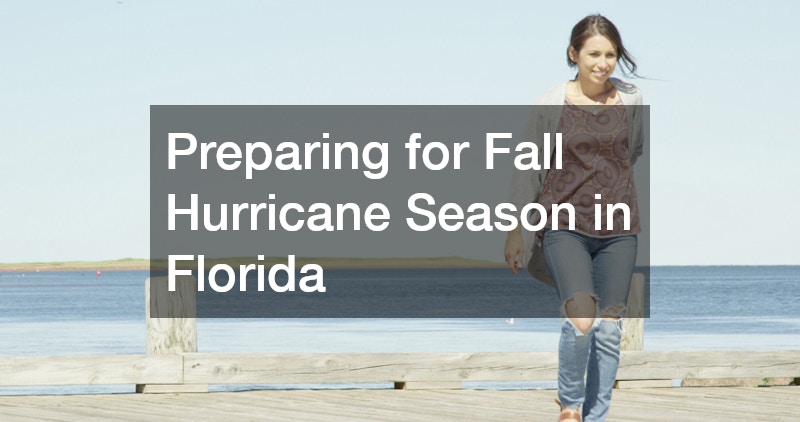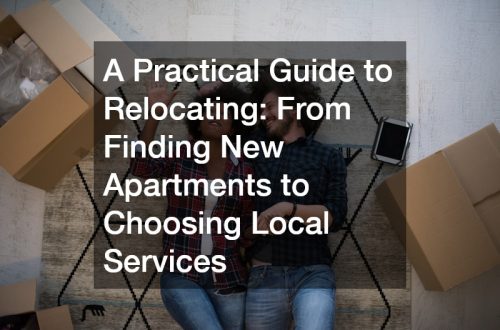Florida’s fall season often brings more than cooler air and changing foliage—it also marks the height of hurricane activity. For residents, this time of year requires thoughtful preparation, awareness, and practical strategies to reduce potential risks. Hurricanes can form quickly and their impacts can vary, from heavy rain and strong winds to flooding and extended power outages. Because of the unpredictability of these storms, homeowners and businesses alike need to take proactive steps to safeguard their properties and families before severe weather hits.
Unlike other natural disasters, hurricanes give some degree of warning. Yet, that window of time can be short, making advanced preparation essential. Stocking up on supplies, securing structures, and understanding community evacuation plans are all critical aspects of readiness. Additionally, fall hurricanes often occur back-to-back, which means resources can quickly become limited in local stores and community shelters. By planning ahead, households can avoid unnecessary stress and minimize damage.
This article will guide Florida residents through the key steps of preparing for fall hurricanes. From reinforcing homes to understanding the role of professional services, each section will provide insights into how individuals can protect their safety and property. The discussion will also highlight how partnering with local experts, staying informed, and maintaining a proactive mindset can help ensure a smoother experience during the storm season. By learning practical strategies now, residents will be better equipped when hurricanes inevitably arrive.
1. Reinforcing Water Systems and Protecting the Home

When storms bring heavy rainfall and flooding, one of the first vulnerabilities many homeowners face is plumbing. A reliable plumbing company can be invaluable for inspecting systems, clearing drains, and ensuring pipes are strong enough to withstand pressure from excessive water flow. For those preparing for fall, this kind of preventative care can help minimize costly damage later. Backflow issues and burst pipes are common during hurricanes, and addressing weaknesses early keeps your home’s water systems functioning when they’re needed most.
Beyond pipes, homeowners should consider how flooding might impact other areas of their house. Properly sealing windows and checking for foundation cracks reduces the risk of water seeping indoors. Since storms often leave residents unable to access help quickly, reinforcing these systems before hurricane season provides extra peace of mind. Even small adjustments can mean the difference between minor inconvenience and significant repair bills once the skies clear.
2. Staying Powered During Outages
Power outages are almost guaranteed during severe storms, which makes having an emergency generator a top priority. For households preparing for fall, securing reliable backup power allows essential systems like refrigerators, medical equipment, and communication devices to remain operational. Hurricanes often knock out electrical lines for days or even weeks, and a generator bridges that gap until services can be restored.
Residents should not only invest in a generator but also test it regularly. Fuel storage, ventilation, and proper hookups are all critical elements to consider. In many cases, storms arrive with little warning, leaving little time to troubleshoot issues. Taking proactive steps to maintain and understand how to operate a generator can make post-storm life much safer and more comfortable. With dependable power in place, households are far less vulnerable to disruptions caused by hurricanes.
3. Managing Trees and Outdoor Hazards
One of the most overlooked but critical aspects of storm preparation is tree management. Branches, limbs, and entire trees can become dangerous projectiles in hurricane-force winds. A trusted local tree company can inspect properties and remove weak or overhanging limbs before storms arrive. Preparing for fall hurricanes with this precaution ensures a safer environment and reduces the risk of structural damage to homes, vehicles, and power lines.
Beyond trimming, homeowners should also look at outdoor areas for other hazards. Patio furniture, grills, and yard equipment should be secured or stored indoors. Even seemingly harmless items can cause significant damage when lifted by high winds. Proactively clearing and securing outdoor spaces provides an added layer of safety, giving homeowners peace of mind as storms approach.
4. Ensuring Electrical Safety Before Storms

Electrical systems are another area of vulnerability during hurricanes. Licensed electricians can assess wiring, breakers, and critical circuits to ensure everything is functioning safely before the first storm clouds appear. For those preparing for fall, inspections and upgrades to surge protection systems are especially valuable, as lightning strikes and power surges are common during tropical weather.
Homeowners should also develop habits that reduce electrical risks during storms, such as unplugging non-essential appliances and avoiding the use of water when lightning is nearby. By taking these measures and relying on expert guidance, residents can reduce the chance of fire hazards or long-term electrical damage that could complicate recovery efforts after the storm passes.
5. Protecting Technology and Communication Systems
In today’s connected world, technology is essential for receiving updates and staying safe during hurricanes. Partnering with top IT services providers ensures that important data is backed up and systems are protected against outages or surges. For those preparing for fall, these precautions mean communication and access to vital information remain intact when it matters most.
Residents should also ensure personal devices, such as cell phones and portable chargers, are fully powered before storms. Having offline copies of critical documents, emergency contacts, and evacuation maps provides an additional safety net in case internet access is disrupted. Maintaining access to reliable information is one of the most powerful tools for keeping families safe during uncertain weather conditions.
6. Stocking Up on Essential Supplies
Another cornerstone of preparing for fall hurricanes is creating a robust supply kit. Families should gather at least three days’ worth of food, clean water, and medical supplies, though experts recommend a week or more for added safety. Non-perishable foods, batteries, flashlights, and first-aid items are particularly important, as they may be difficult to find once a storm is imminent.
By building and maintaining this supply kit throughout the season, households can avoid the rush and shortages that occur just before hurricanes hit. It’s also essential to consider the unique needs of pets, infants, and elderly family members. Preparedness kits should be revisited regularly to ensure nothing has expired or been misplaced, leaving families better equipped for whatever the season brings.
7. Fueling and Heating Preparations

Hurricanes not only threaten electricity but also access to fuel sources. Many families rely on propane service for cooking, heating, or powering backup generators. Preparing for fall means checking fuel levels early, scheduling timely deliveries, and ensuring storage tanks are secure. Strong winds and flooding can disrupt distribution systems, so having reserves in place reduces vulnerability during extended outages.
In addition to propane, families should consider other fuel needs such as gasoline for vehicles and generators. Safe storage and regular rotation of these supplies help ensure availability when emergencies strike. Proactive fueling preparations ensure households can maintain a level of normalcy even as the storm disrupts community services.
8. Guarding Against Water Damage
Water intrusion is one of the most damaging aspects of hurricanes. Proactive leak detection services can identify weaknesses in roofs, windows, and plumbing systems before storms hit. For residents preparing for fall, catching these vulnerabilities early helps avoid costly flooding repairs. Even small leaks can expand under hurricane conditions, leading to structural damage, mold, and long-term health hazards.
Simple measures, such as sealing entry points and maintaining gutters, also help protect homes against excessive water. Sandbags or barriers may be necessary for flood-prone areas. By focusing on prevention rather than reaction, homeowners give themselves the best chance of keeping their homes safe and dry.
9. Securing Outdoor and Recreational Spaces
Swimming pools and outdoor areas need attention before hurricanes arrive. Professional swimming pool maintenance services can help homeowners prepare by lowering water levels, securing covers, and balancing chemicals to prevent damage or contamination. Preparing for fall hurricanes with this step ensures pools remain safe and easier to restore after the storm passes.
Additionally, outdoor equipment such as grills, patio furniture, and poolside décor should be stored indoors. These items can become dangerous if left exposed to strong winds. By safeguarding recreational spaces ahead of time, residents reduce risks and simplify cleanup once the skies clear.
10. Creating a Family Communication Plan

While protecting property is important, safeguarding loved ones is the top priority. Preparing for fall also involves developing a clear family communication plan. Every household should decide on meeting points, designate emergency contacts, and ensure all members understand evacuation procedures. Hurricanes often cause confusion and limited communication, making pre-arranged plans vital.
Families should also practice their plan, reviewing evacuation routes and ensuring everyone knows how to respond if separated. This preparation minimizes panic and ensures smoother coordination when quick action is necessary. A strong communication plan is one of the most reliable ways to protect family safety during storm season.
11. Fortifying Roofs and Exteriors
The roof and exterior siding are often the first points of impact during hurricanes. Working with experienced roofers ensures shingles, tiles, and flashing are secure before storms arrive. Likewise, trusted home siding companies can inspect and reinforce vulnerable areas. For homeowners preparing for fall, these professional services provide essential protection against wind and rain damage.
Beyond hiring experts, residents can take additional steps like clearing gutters and downspouts, checking attic ventilation, and securing loose exterior features. These actions, combined with professional inspections, help maintain the integrity of the structure, reducing the risk of extensive repairs after hurricanes pass.
12. Long-Term Resilience and Community Support
While individual households must prepare carefully, long-term resilience depends on community cooperation. By engaging with neighbors, sharing resources, and staying informed through local emergency channels, families can create a safer environment for everyone. Professional partnerships with services like roofers, electricians, home siding companies, and even a reliable plumbing company all contribute to broader preparedness when storms arrive. Preparing for fall is not just about stocking supplies but about strengthening the network of support that communities rely on during crises.
Another important step is reviewing insurance coverage. Many residents discover too late that they lack sufficient protection for flood damage or storm-related repairs. By reviewing policies before hurricane season peaks, homeowners can make informed choices and avoid financial setbacks later. Regular property inspections and ongoing relationships with trusted service providers create a cycle of preparedness that grows stronger each year.
Finally, resilience means adopting a mindset that hurricanes are not one-time events but recurring challenges. Proactive habits, from regular leak detection to ongoing swimming pool maintenance, reinforce the ability of families and communities to recover more quickly. By blending preparation, professional guidance, and community strength, Florida residents can face fall hurricanes with confidence, knowing they have done everything possible to safeguard their lives and homes.
Preparing for fall hurricanes in Florida requires both individual responsibility and community cooperation. By addressing vulnerable systems, reinforcing homes, and stocking necessary supplies, residents can significantly reduce risks and stress when storms hit. Professional support from local experts—whether it be a plumbing company, electricians, roofers, or other service providers—adds another layer of security that homeowners should not overlook.
Equally important is the mental aspect of preparation. Families who develop clear communication plans, stay connected with neighbors, and maintain a proactive mindset will be better positioned to weather both the storm itself and the challenges that follow. The unpredictability of hurricanes makes preparation essential rather than optional, and early action ensures resources remain available when needed most.
While no plan can completely eliminate the risks of hurricanes, the strategies outlined in this guide provide a strong foundation for resilience. By focusing on both the physical and emotional aspects of readiness, Florida residents can transform an otherwise overwhelming season into one they can face with confidence. With preparation, awareness, and collaboration, households will be better equipped to endure hurricane season and recover more quickly once the skies clear.
Beyond immediate preparations, cultivating long-term awareness and adaptability is essential for Florida residents. Hurricanes are unpredictable, and each season may present new challenges, from stronger storms to changing evacuation routes. By maintaining regular communication with neighbors, local authorities, and service providers, households can respond more effectively when conditions change. Documenting important contacts, property details, and emergency plans ensures that families are not scrambling for information when it is most needed. Preparing for fall hurricanes also means fostering a mindset of resilience—accepting that while some damage may be unavoidable, proactive steps can drastically reduce risk. Regularly reviewing systems such as plumbing, roofing, and electrical components, along with staying up to date on safety recommendations, reinforces a culture of preparedness. With these ongoing habits, residents can confidently navigate hurricane season, safeguard their homes, and protect their families, turning what might feel like an overwhelming threat into a manageable part of life in Florida.





